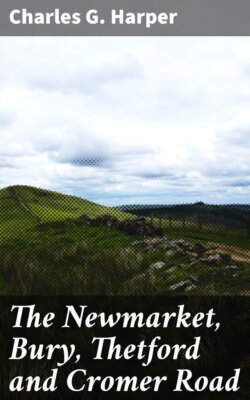Читать книгу The Newmarket, Bury, Thetford and Cromer Road - Charles G. Harper - Страница 14
На сайте Литреса книга снята с продажи.
VII
ОглавлениеTable of Contents
The entrance to Epping Forest, the greenwood tree aforesaid, is by way of Snaresbrook, past the Eagle Pond, a pleasant lake which takes its name from that old coaching-house, the “Eagle,” pictured here in the old print after Pollard. It is more than seventy years since that Old Master of coaching subjects painted this view of the Norwich Mail passing by, but the old house still stands, not so very greatly altered. Pollard has made it and its surrounding trees look more of the Noah’s Ark order of architecture than ever they were.
Epping Forest is a glorious heritage, of which any city might well feel proud, and the public-spirited act of the Corporation of the City of London, by which it was secured in 1882 as a forest, for ever, for the free enjoyment of all, has never been fully appreciated. These are the days of popularly-elected bodies, dependent upon the votes of the million, and every little thing they perform at the public expense is trumpeted as though it were a benevolence. The Corporation of the City, however, is not elected by a popular vote, and is accustomed to do things without an eye upon the next election. It purchased Epping Forest in a purely public spirit, and administers it in precisely the same way. The thing was done none too soon, for nerveless and conflicting interests had long permitted squatters to settle in the Forest lands, and already the suburban builder had begun to make his mark. As we pass the many Woodfords—Woodford, Woodford Green, and Woodford Wells—and come to Buckhurst Hill, the patches and snippets of common, village greens, and wayside selvedges of grass, saved with difficulty, show, outside the Forest proper, how the rural character was going.
Beyond Woodford Wells the way divides, to rejoin in less than three miles. To the right hand it leads through Loughton, and to the left past the more sylvan stretch by High Beech Green. “Here,” one might say, with Longfellow, “here is the Forest primeval”; and tangled glades, marshy hollows, and secluded lawns are glimpsed by the traveller in passing, between the massy boles of immemorial trees. Not yet, fortunately, has the floor of the Forest been levelled and drained, and made like a London park, and it is still possible to find places with uncanny names, in an uncanny condition. Thus, Deadman’s Slade is still as slippery a hollow as when it first obtained that name. Essex rustics have now forgotten many old words, and people who fall on ice or grease now slip because it is slippery; but not so long ago, throughout the whole of East Anglia, folks “slumped” because it was “slade.”
THE “WHITE HART,” WOODFORD.
From a drawing by P. Palfrey.
It was most terrible, this woodland road in the old times, and the nocturnal voices of the Forest had heart-shaking significances. The pit-a-pat of heavy dewdrops from leafy boughs on to the dried leaves of last autumn sounded for all the world like the stealthy footfalls of some lurking footpad, and the rise of some couching deer or the scuttle of a rabbit made the traveller stand still and face about, lest the rushing attack of the imaginary assassin should take him in the rear. Even the hooting of the owls, one against the other, were sounds of dread, and for all the world like rallying calls of midnight prowlers on their unholy errands
